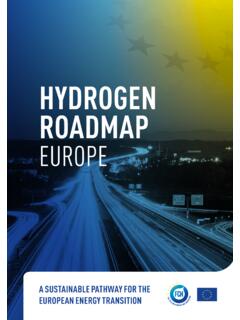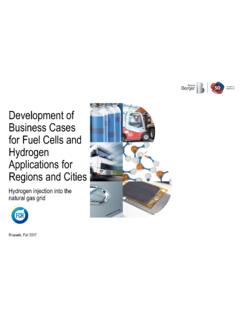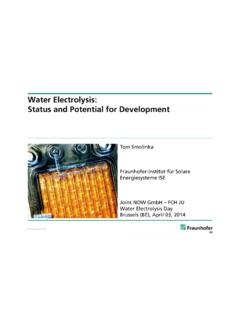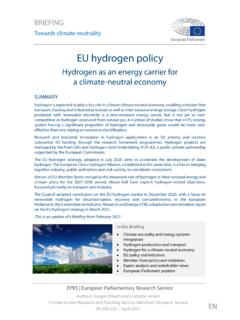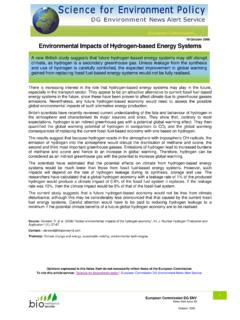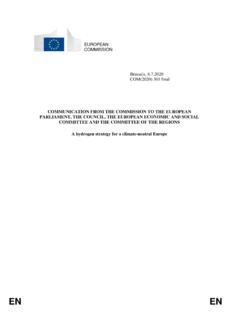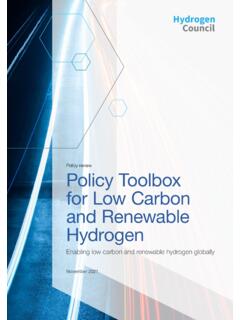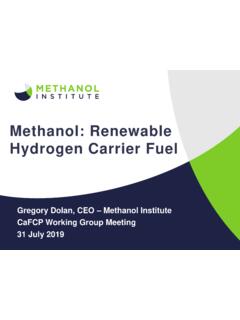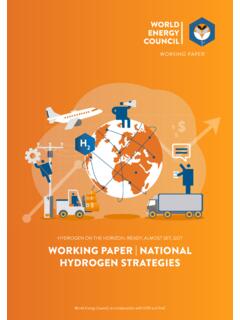Transcription of Hydrogen-powered aviation - www.fch.europa.eu
1 Hydrogen-powered aviation A fact-based study of hydrogen technology, economics, and climate impact by 2050. May 2020. This document reflects the results of a fact-based study prepared by McKinsey & Company for the Clean Sky 2 JU and Fuel Cells and hydrogen 2 JU (hereafter the Joint Undertakings). This study was jointly procured by the Clean Sky 2 JU and FCH 2 JU and received financial support under the H2020 Framework Programme. The following 24 companies and organizations provided inputs and contributed to this study: Airbus, Air Liquide, ArianeGroup, Ballard Unmanned Systems, Bauhaus Luftfahrt , Boeing, BP International Limited, Cranfield University, Equinor ASA, easyJet Airline Company Ltd, German Aerospace Center (DLR), GKN Aerospace Services Limited, Groupe ADP, Hydrogenics (now part of Cummins Inc.), Intelligent Energy, Liege Airport, Linde Technology, Plug Power, PowerCell Sweden AB, Safran Group, Schiphol Group, Shell International Petroleum Company, TU Delft, and ZeroAvia.
2 This independent study was drawn up with inputs and contributions from the stakeholders listed above based on the proposed methodology of analysis. The information and conclusions contained in this document represent their collective view for the sake of the analysis performed under the study and not that of individual companies or organisations. Any information and conclu- sions provided in this document are for reference purposes only and are not intended, nor should they be used as a substitute for professional advice or judgement with respect to certain circumstances. None of the stakeholders listed above guarantees the adequacy, accuracy, timeliness or completeness of the document's contents. Said stakeholders therefore disclaim any and all warranties and representations as to said contents, express or implied, including any warranties of fitness for a particular purpose or use.
3 The document reflects the views only of the authors and not the official views of the Joint Undertakings nor of its public (the european union ) and private Members. The Joint Undertakings cannot be held liable for any use which may be made of the information contained therein. Clean Sky 2 JU, 2020, FCH 2 JU, 2020, Printed by The Print Agency in Belgium Manuscript completed in May 2020. First edition The Joint Undertakings are not liable for any consequence stemming from any possible reuse of this publication. The reuse policy of european Commission documents is regulated by Decision 2011/833/EU (OJ L 330, , p. 39) and applies mutatis mutandis. Luxembourg: Publications Office of the european union , 2020. Print ISBN 978-92-9246-341-0 EG-04-20-214-EN-C. PDF ISBN 978-92-9246-342-7 EG-04-20-214-EN-N. Reuse is authorised provided the source is acknowledged.
4 For any use or reproduction of photos or other material that is not under the copyright of Clean Sky 2 JU or FCH 2 JU, permission must be sought directly from the copyright holders. Copyrights photographs Airbus 2020 MAVERIC, computer rendering by FIXION, photo by (title page). TU Delft Flying V, image from Edwin Wallet at OSO Studio for TU Delft (page 68). Getty Images, Inc. (title page, pages 4, 10, 14, 29, 36, 41, 50, 59, 60, 65, 67, 69, 73, 74, 84, back cover). Shutterstock, Inc. (pages 9, 33, 71). ZeroAvia converted Piper (page 22, 65). 2 Hydrogen-powered aviation | A fact-based study of hydrogen technology, economics, and climate impact by 2050. Hydrogen-powered aviation A fact-based study of hydrogen technology, economics, and climate impact by 2050. May 2020. 3. 4 Hydrogen-powered aviation | A fact-based study of hydrogen technology, economics, and climate impact by 2050.
5 Executive summary Decarbonization is a major challenge for aviation . The aviation sector emits more than 900 million tons of carbon dioxide (CO2) per year. Assuming industry growth of 3 to 4 percent per annum ( ) and efficiency improvement of 2 percent , emissions would more than double by 2050. In the same time period, the Air Transport Action Group (ATAG) committed to 50 percent CO2 emission reduction (compared to 2005) and the european union (EU) set with the Green Deal a target to become carbon neutral. Beyond CO2, aircraft impact the climate through emissions of nitrogen oxides (NOx), soot, and water vapor, which create contrails and cirrus clouds. Therefore, the full contribution to global warming is significantly higher than just CO2 emissions alone. This report assesses the potential of hydrogen (H2) propulsion H2 combustion could to reduce aviation 's climate impact.
6 To reduce climate impact, the industry will have to introduce further levers such as radically new reduce climate technology, significantly scale sustainable aviation fuels (SAF) such as synthetic fuel (synfuel), temporarily rely on offsets in large quanti- impact ties, or rely on a combination thereof. H2 propulsion is one such tech- in flight by 50 to nology, and this report assesses its potential in aviation . Developed with input from leading companies and research institutes, it 75 percent, and projects the technological development of H2 combustion and fuel fuel-cell propulsion cell-powered propulsion, evaluates their technical and economic feasibility, compares them to synfuel, and considers implications on by 75 to 90 percent. aircraft design, airport infrastructure, and fuel supply chains. The report's overall conclusion is that hydrogen propulsion has the potential to be a major part of the future propulsion technology mix.
7 As a disruptive innovation it will require significant research and development, investments, and accompanying regulation to ensure safe, economic H2 aircraft and infrastructure mastering climate impact. The findings and factors supporting this conclusion are: H2 propulsion could significantly reduce climate impact. hydrogen eliminates CO2 emissions in flight and can be produced carbon-free. Considering also non-CO2 emissions, and taking into account the uncertainties of these effects1, the latest estimates show that H2 combustion could reduce climate impact in flight by 50 to 75. percent, and fuel-cell propulsion by 75 to 90 percent. This compares to about 30 to 60 percent for synfuels. To scale H2-powered aircraft, several technological unlocks need to happen: enhancing the overall efficiency with lighter tanks (targeting 12 kWh/kg / gravimetric index of 35%) and fuel cell systems (targeting 2 kW/kg incl.)
8 Cool- ing), liquid hydrogen (LH2) distribution within the aircraft, turbines capable of burning hydrogen with low-NOx emis- sions, and the development of efficient refueling technologies enabling flow rates comparable to kerosene need to be developed. Industry experts project these important advancements are possible within five to ten years. Assuming these technical developments, H2 propulsion is best suited for commuter, regional, short- range, and medium-range aircraft. For commuter and regional aircraft, fuel cell-powered propulsion emerg- es as the most energy-efficient, climate-friendly, and economic option. Compared to conventional aircraft, operational costs increase by as little as US $5-10 per passenger, about 10 percent per PAX (passenger). This is even before carbon costs and considering all direct infrastructure and CAPEX costs, but not indirect infrastructure costs like potential changes to airport layout that remain highly uncertain.
9 Entry into service could happen within the next eight to fifteen years. For short-range aircraft, a hybrid propulsion approach (H2 combustion and fuel cell) could be best suited, increasing costs per PAX by 20-30 percent. The next largest segment, medium-range aircraft, requires significantly extended fuselages for LH2 storage and thus 1. The exact climate impact of non-CO2 emissions of aviation is a matter of scientific debate. Please see chapter 1 on climate change for estimates by technology and annex 1 for the methodology and sources behind these estimates. Executive summary 5. would consume about 25 percent more energy than conventional aircraft; these aircraft would lead to a cost increase of 30-40 percent per PAX. Considering the amount of climate impact avoided, this translates into costs per abated ton of CO2 equivalent of less than US $60 for regional and commuter and US $70 to $220 for short- and medium-range aircraft.
10 This compares favorably to US $210 to $230 per ton CO2eq for synfuel from direct air capture for short- to long-range aircraft. Long-range aircraft require new aircraft designs for hydrogen . H2 is technically feasible but less suitable for evolutionary long-range aircraft designs from an economic perspective. The hydrogen tanks would increase airframe length and energy demand, resulting in 40 percent to 50 percent higher costs per PAX. Synfuel is likely the more cost-effective decarbonization solution. New aircraft designs ( , blended-wing-body) could change that but may be at least 20 years away from entry into service. Feasibility and economic analyses show hydrogen can be a major part of aviation 's future technology mix. If H2-powered aircraft are deployed in segments where they are the most cost-efficient means of decar- bonization, they could account for 40 percent of all aircraft by 2050, with this share further increasing after 2050.
